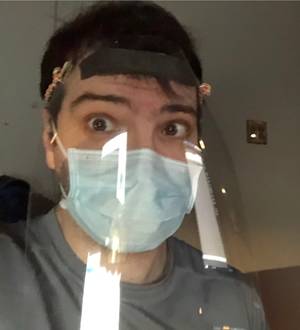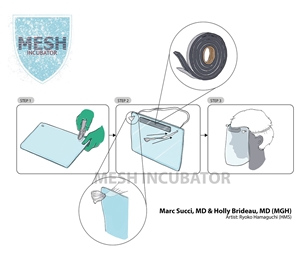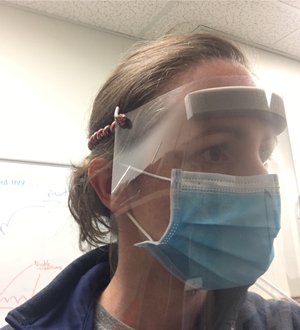As COVID-19 spreads across the U.S., hospitals nationwide have reported severe shortages in personal protective equipment (PPE). As a result, healthcare providers have taken to social media to plead for more face shields, masks, gowns, and other gear as they care for patients overcome with the disease. In response, many people — from ordinary citizens to healthcare professionals — have stepped up to help develop PPE for providers on the front lines. Massachusetts General Hospital (MGH) emergency department radiologist Marc D. Succi, MD, and chief radiology resident Holly R. Brideau, MD, are among the many physicians nationwide who have joined the effort.
Succi is the founder and executive director of MGH’s Medically Engineered Solutions in Healthcare (MESH) Incubator, an innovation and entrepreneurship lab where radiologists and other physicians can turn their product ideas into reality. (Learn more about MESH in this case study.) As Succi listened to the news and read social media posts from healthcare providers about PPE deficiencies, he saw an opportunity to use the expertise and technology, such as 3D-printing, silicone molding, and advanced thermoplastics, within the MESH Incubator to help address the crisis.
“The incubator’s mission is to develop user-centered products to help physicians and other healthcare professionals deliver patient care,” says Succi, who continues to read imaging studies full time while developing PPE solutions. “We have the tools and the resources, so we’re just hoping to contribute.”

Emergency department radiologist Marc D. Succi, MD, founder and executive director of Massachusetts General Hospital’s Medically Engineered Solutions in Healthcare Incubator, led development of a simple, low-cost face shield in response to the personal protective equipment shortage. |
As he considered how the incubator might help, Succi saw an immediate need for the disposable face shields that healthcare providers typically wear for protection from fluids like saliva that can transmit diseases, including COVID-19. As he prepared to develop a solution, Succi recruited Brideau, a standout who he had previously taught in the MESH Core Innovation bootcamp, for help. The two developed a design hat anyone could use to make low-cost face shields using readily available materials not in the current PPE supply chain: clear binder covers, foam weather stripping, and elastic roll gauze.
“We decided to start with face shields because they’re simple devices that are designed to be disposable,” Succi says. “We knew they wouldn’t be too difficult to make with a diversified supply of materials, yet they would have a significant impact.”
Reverse-Engineered Design
At the project’s outset, Succi and Brideau examined a discarded commercially manufactured face shield to better understand its design. They initially thought about 3D-printing the shields, but after they considered the disposable nature of the devices (most hospitals don’t have a workflow in place to properly sanitize the shields for reuse) as well as the relatively expensive price per unit of 3D-printed materials, Succi and Brideau decided against using the technology. “The commercially available shield design is very effective,” explains Brideau, whose background is in bio-medical and mechanical engineering. “So instead of starting from scratch, we analyzed the current design and reverse engineered a low-tech solution.”
Succi and Brideau say that keeping the design machine-free was crucial because many hospitals and healthcare providers do not have 3D-printing, laser cutting, or other machining capabilities that are popular with the industrial community. They wanted to offer a solution that individuals could immediately assemble and use without having to rely on MGH or another institution to make and ship the devices. “No matter how good the design is, if you do not have the tools to build it, it’s a moot point — this is about access as much as it is about effectiveness,” Succi says.
Along those lines, Brideau adds, “We often hear of large hospital systems running low on PPE, but home health workers, nursing homes, low-resource settings, and other providers also need solutions quickly. We wanted this design to be available to all providers and healthcare workers to ensure that everyone has the same access to PPE.”

The face shield features an intentionally simple design that uses readily available materials not in the current PPE supply chain: clear binder covers, foam weather stripping, and elastic roll gauze. |
To that end, Succi and Brideau began working on a prototype using off-the-shelf materials. They experimented with their own 3D-printed frames, polyvinyl chloride sheets, and other materials but felt like they were still over-engineering the solution. Ultimately, they turned to clear plastic binder covers purchased from an office supply store, foam weather stripping from a home improvement center, and self-adhering elastic bandage — a staple in most first-aid kits or hospital supply closets.
“All you do is punch a couple of holes in the clear binder cover, place the foam weather stripping between the holes for your forehead, and then weave elastic bandage through the holes, which is held by the innate tension of the band, and you’re done,” Succi explains. “It’s designed to be disposable, quick to assemble, and extremely cheap to make at anywhere between 5 and 20 cents per unit, depending on if you buy the materials in bulk or off the shelf.”
A Simple Solution
Succi and Brideau have made about 10 prototypes using the design. As MGH has since secured their supply chain without requiring in-house manufactured PPE, they have shared the design — branded the MESH Simple Shield — on
MESH’s website . Succi received several requests from nurses and doctors in New York for the design, and he has sent them assembly videos and instructions. He was also told that several colleagues referred their friends to the MESH design. “It’s really intended to be used in low-resource settings,” Succi says. “It hasn’t been clinically tested and should be used as a last resort. It’s a simple solution for a simple problem.”
While the face shield design is deliberately low-tech, Succi and Brideau are also helping with more complex product designs in response to the PPE shortage, including development of N95 respirators in conjunction with popular sneaker manufacturers as well as processes for handling contaminated PPE in the field. As they work on these products, they continue to keep MGH’s legal and intellectual property offices updated about their efforts.
“The pandemic has created a unique situation, where something you develop might be released to the public very quickly,” Succi says. “It’s important to have all of your bases covered and buy in from the relevant players. The last thing anyone would want to do is put something out there without the appropriate disclaimers and guidelines, potentially resulting in confusion and unintended use by the end user.”

Chief Radiology Resident Holly R. Brideau, MD, says, “We wanted this design to be available to all providers and healthcare workers to ensure that everyone has the same access to PPE.” |
With that in mind, Succi recommends that all healthcare professionals get involved in product design to generate user-centered products. “A lot of people, companies, startups, and engineers are proposing or have already built designs that are not viable in a healthcare setting because they don’t know how these products are used by the end user,” Succi says. “I would encourage frontline users of this equipment to get in touch with anyone who’s engineering these products to provide your expertise in order to reduce product cycles and get useful products out to users faster.”
Succi notes that you can often find these “makers” at nearby universities and labs, and, if you are not based at an academic center, consider contacting textile and device manufacturers, many of which have repurposed their product lines to manufacture PPE. Radiologists are particularly well suited for this work because they often have both strong clinical and technical expertise — affording them yet another opportunity to make a significant impact on patient care.
“There are many ways to care for patients, and this is one of them,” Succi says. “Radiologists might not necessarily be directly triaging patients as part of the pandemic, but we can certainly contribute by taking care of the people on the front lines.”




